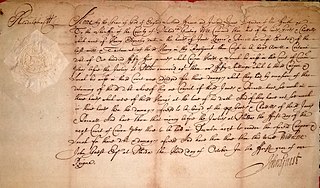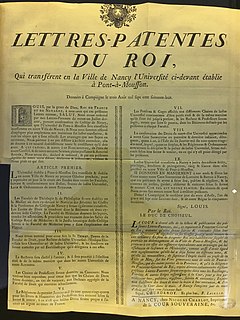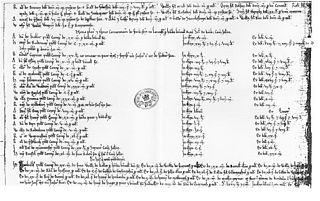Related Research Articles

In law, common law, also known as judicial precedent, judge-made law, or case law, is the body of law created by judges and similar quasi-judicial tribunals by virtue of being stated in written opinions. The defining characteristic of “common law” is that it arises as precedent. In cases where the parties disagree on what the law is, a common law court looks to past precedential decisions of relevant courts, and synthesizes the principles of those past cases as applicable to the current facts. If a similar dispute has been resolved in the past, the court is usually bound to follow the reasoning used in the prior decision. If, however, the court finds that the current dispute is fundamentally distinct from all previous cases, and legislative statutes are either silent or ambiguous on the question, judges have the authority and duty to resolve the issue. The court states an opinion that gives reasons for the decision, and those reasons agglomerate with past decisions as precedent to bind future judges and litigants. Common law, as the body of law made by judges, stands in contrast to and on equal footing with statutes which are adopted through the legislative process, and regulations which are promulgated by the executive branch. Stare decisis, the principle that cases should be decided according to consistent principled rules so that similar facts will yield similar results, lies at the heart of all common law systems.
Lord is an appellation for a person or deity who has authority, control, or power over others, acting as a master, chief, or ruler. The appellation can also denote certain persons who hold a title of the peerage in the United Kingdom, or are entitled to courtesy titles. The collective "Lords" can refer to a group or body of peers.
In law, certiorari is a court process to seek judicial review of a decision of a lower court or government agency. Certiorari comes from the name of an English prerogative writ, issued by a superior court to direct that the record of the lower court be sent to the superior court for review. The term is Latin for "to be made certain", and comes from the opening line of such writs, which traditionally began with the Latin words "Certiorari volumus...".

In common law, a writ is a formal written order issued by a body with administrative or judicial jurisdiction; in modern usage, this body is generally a court. Warrants, prerogative writs, subpoenas, and Certiorari are common types of writ, but many forms exist and have existed.
In law, especially British and American common law, quo warranto is a prerogative writ requiring the person to whom it is directed to show what authority they have for exercising some right, power, or franchise they claim to hold. Quo warranto is also used, with slightly different effect, in the Philippines.
A subpoena or witness summons is a writ issued by a government agency, most often a court, to compel testimony by a witness or production of evidence under a penalty for failure. There are two common types of subpoenas:
- subpoena ad testificandum orders a person to testify before the ordering authority or face punishment. The subpoena can also request the testimony to be given by phone or in person.
- subpoena duces tecum orders a person or organization to bring physical evidence before the ordering authority or face punishment. This is often used for requests to mail copies of documents to requesting party or directly to court.

Letters patent are a type of legal instrument in the form of a published written order issued by a monarch, president, or other head of state, generally granting an office, right, monopoly, title, or status to a person or corporation. Letters patent can be used for the creation of corporations or government offices, or for granting city status or a coat of arms. Letters patent are issued for the appointment of representatives of the Crown, such as governors and governors-general of Commonwealth realms, as well as appointing a Royal Commission. In the United Kingdom they are also issued for the creation of peers of the realm.
The forms of action were the different procedures by which a legal claim could be made during much of the history of the English common law. Depending on the court, a plaintiff would purchase a writ in Chancery which would set in motion a series of events eventually leading to a trial in one of the medieval common law courts. Each writ entailed a different set of procedures and remedies which together amounted to the "form of action".

Henry of Bracton, also Henry de Bracton, also Henricus Bracton, or Henry Bratton also Henry Bretton was an English cleric and jurist.

The Pipe rolls, sometimes called the Great rolls, or the Great Rolls of the Pipe are a collection of financial records maintained by the English Exchequer, or Treasury, and its successors. The earliest date from the 12th century, and the series extends, mostly complete, from then until 1833. They form the oldest continuous series of records concerning English governance kept by the English, British and United Kingdom governments, covering a span of about 700 years. The early medieval ones are especially useful for historical study, as they are some of the earliest financial records available from the Middle Ages. A similar set of records was developed for Normandy, which was ruled by the English kings from 1066 to 1205, but the Norman Pipe rolls have not survived in a continuous series like the English.
Vill is a term used in English history to describe the basic rural land unit, roughly comparable to that of a parish, manor, village or tithing.

The Court of Common Pleas, or Common Bench, was a common law court in the English legal system that covered "common pleas"; actions between subject and subject, which did not concern the king. Created in the late 12th to early 13th century after splitting from the Exchequer of Pleas, the Common Pleas served as one of the central English courts for around 600 years. Authorised by Magna Carta to sit in a fixed location, the Common Pleas sat in Westminster Hall for its entire existence, joined by the Exchequer of Pleas and Court of King's Bench.
In English law, the assize of novel disseisin was an action to recover lands of which the plaintiff had been disseised, or dispossessed. It was one of the so-called "petty (possessory) assizes" established by Henry II in the wake of the Assize of Clarendon of 1166; and like the other two was only abolished in 1833.

Bryan Andrew Garner is an American lawyer, lexicographer, and teacher who has written more than two dozen books about English usage and style such as Garner's Modern English Usage for a general audience, and others for legal professionals. He also wrote two books with Justice Antonin Scalia: Making Your Case: The Art of Persuading Judges (2008) and Reading Law: The Interpretation of Legal Texts (2012).
The Close Rolls are an administrative record created in medieval England, Wales, Ireland and the Channel Islands by the royal chancery, in order to preserve a central record of all letters close issued by the chancery in the name of the Crown.

The courts of assize, or assizes, were periodic courts held around England and Wales until 1972, when together with the quarter sessions they were abolished by the Courts Act 1971 and replaced by a single permanent Crown Court. The assizes exercised both civil and criminal jurisdiction, though most of their work was on the criminal side. The assizes heard the most serious cases, which were committed to it by the quarter sessions, while the more minor offences were dealt with summarily by justices of the peace in petty sessions.
Law Latin, sometimes written L.L. or L. Lat., and sometimes derisively called Dog Latin, is a form of Latin used in legal contexts. While some of the vocabulary does come from Latin, many of the words and much of the vocabulary stem from English. Law Latin may also be seen as consisting of a mixture of English, French and Latin words superimposed over an English syntax.
The Clerk of the Crown and Hanaper was a civil servant within the Irish Chancery in the Dublin Castle administration. His duties corresponded to the offices of Clerk of the Crown and Clerk of the Hanaper in the English Chancery. Latterly, the office's most important functions were to issue writs of election to the Westminster Parliament, both for the Commons and for Irish representative peers in the Lords.
The Grand Assize was a legal instrument set up in 1179 by King Henry II of England, to allow tenants to transfer disputes over land from feudal courts to the royal court.
References
- ↑ B. A. Garner, A Dictionary of Modern Legal Usage (2001) p. 679
- ↑ G. O. Sayles, The Medieval Foundations of England (London 1966) p. 333
- ↑ J. R. Tanner ed., The Cambridge Medieval History Vol V (Cambridge 1926) p. 588
- ↑ S. H. Steinberg ed., A New Dictionary of British History (London 1963) p. 123 and p. 284
- ↑ G. O. Sayles, The Medieval Foundations of England (London 1966) p. 401
- ↑ B. A. Garner, A Dictionary of Modern Legal Usage (2001) p. 679
- ↑ Chandrachud, Abhinav (2016-02-19). "Litigation 101: Bombay High Court Practice and Procedure". Law and Other Things. Retrieved 2019-03-19.